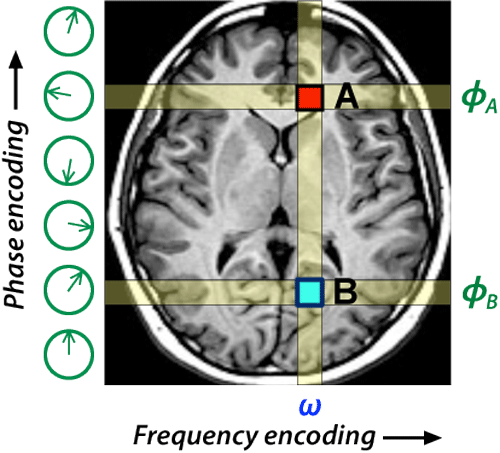Although frequency components can be uniquely decoded by Fourier transformation from a single echo, the individual phase shifts contributed by each pixel cannot. This non-uniqueness of phase information can be easily illustrated by the following example.
|
Consider two pixels, A and B, lying along the same frequency encoding column in an image, but with different gradient-induced phase shifts. Let pixel A generate an MR signal of the form A(t) = sin(ωt + ϕA), and let pixel B generate a signal B(t) = sin(ωt + ϕB).
In an imaging experiment we measure an echo that contains the sum A(t) + B(t). We now use a fundamental trigonometric identity about the sum of two sine waves (often learned in high school math, but forgotten): sin X + sin Y = 2 sin [½(X+Y)] cos [½(X−Y)]
|
Replacing X with (ωt + ϕA) and Y with (ωt + ϕB) and simplifying, we obtain:
A(t) + B(t) = 2 sin [ωt + ½(ϕA+ϕB)] cos [½(ϕA−ϕB)]
This equation shows that the combination of the signals (A + B) results in a sine wave of the same base frequency (ω), but with an averaged phase shift of ½(ϕA+ϕB). From a single measurement we cannot determine the phase contributions from A or B individually. For clinical MR imaging, therefore, multiple phase-encoding steps must be used to sort out spatial information in the phase-encoding direction.
Advanced Discussion (show/hide)»
Like many others on the web site, this is a simplified example for illustrative purposes only. The trigonometric identity cited only holds when the sine waves have exactly the same amplitudes; a more complex form is needed in general. Still, the basic idea holds true that the resultant phase of the sum is a mixture of phases from the contributing waves and the individual components cannot be determined from a single measurement alone.
References
Lyons R. Sum of two sinusoids (pdf). (A nice little paper from dspguru.com that tabulates a variety of trigonometric identities for the sum of various combinations of sine and cosine waves).
Lyons R. Sum of two sinusoids (pdf). (A nice little paper from dspguru.com that tabulates a variety of trigonometric identities for the sum of various combinations of sine and cosine waves).
Related Questions
I understand the 2-pixel example, but I still can't put it all together with the whole image and frequency encoding. Can you help?
I understand the 2-pixel example, but I still can't put it all together with the whole image and frequency encoding. Can you help?

